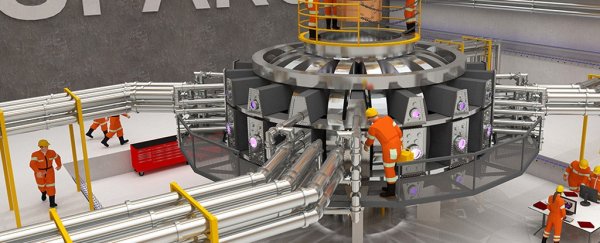The most promising source of clean energy humans can ever hope for is still fusion power - and researchers at MIT have just received US$30 million in funding to help make it happen.
MIT has joined forces with a newly formed private company called Commonwealth Fusion Systems, and together they hope to have a pilot fusion power plant in 15 years' time.
Not to be confused with nuclear fission, which is what nuclear power consists of today and which is based on atom-splitting, nuclear fusion generates power by fusing hydrogen atoms into helium.
It's the same kind of nuclear process that takes place inside stars, including our own Sun. The heat that fusion produces can run into hundreds of millions of degrees Celsius - and, if it can be harnessed, this heat could be converted into immense amounts of electricity.
Scientists have been working on developing a fusion reactor since the 1940s. So far the problem with every attempt has been generating as much power as the reactors take to run, never mind exceeding it.
One of the most promising designs for a nuclear fusion reactor is the tokamak, a chamber that uses powerful magnets to create a magnetic field to confine the hot plasma produced by nuclear fusion in the shape of a torus, or doughnut.
MIT is hoping to build a compact tokamak, called SPARC, capable of generating 100 megawatts of heat. This won't be converted to electricity, but it will be used to produce 10-second pulses of enough power for a small city - and more than twice the power needed to heat the plasma.
This will help reach the technical milestones required to build a prototype full-scale fusion reactor with a capacity of 200MW.
Key to building this compact tokamak will be developing the world's most powerful superconducting magnets. MIT will be spending the first three years of the project developing these.
They'll be based on a superconducting material that only recently became commercially available, a steel tape coated with a superconducting compound called yttrium-barium-copper oxide (YBCO).
These magnets should generate four times as strong a magnetic field and tenfold the power output of any existing fusion experiment, according to the team.
The YBCO tape could also reduce the cost, time and complexity of building fusion devices, as well as the size of the plants, making it more accessible purely on a practical level.
"By putting the magnet development up front," said Dennis Whyte, director of MIT's Plasma Science and Fusion Center, "we think that this gives you a really solid answer in three years, and gives you a great amount of confidence moving forward that you're giving yourself the best possible chance of answering the key question, which is: Can you make net energy from a magnetically confined plasma?"
Of course, MIT is not the only facility devoting time and energy to solving the problem of fusion power. The international ITER collaboration based in France is currently constructing a giant tokamak to run the world's largest magnetic plasma physics experiment, starting in 2025.
Tokamak Energy in the UK is also using miniature tokamaks to test ideas faster than can be achieved with the larger reactors, in the race towards a fusion future.
